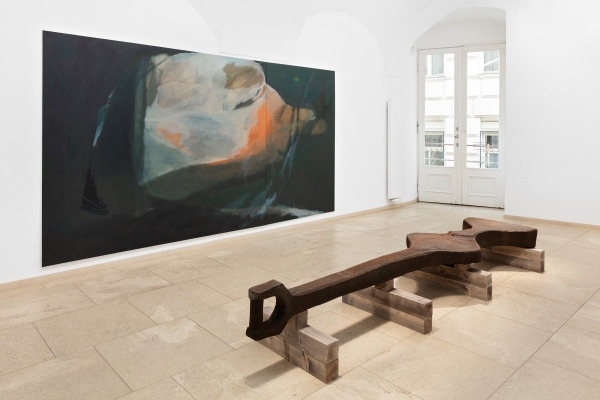Konstanze Stoiber
There Have to be Bells
The opening sequence of Ingmar Bergman’s film Fanny and Alexander
from the year 1982 shows the young protagonist, Alexander, engrossed in play. In the candle-lit scene he is cautiously – as
if in a stage-performance – shifting figures around in his toy theatre, creating a variety of perspectives and relationships.
The shooting script of this film is displayed in Konstanze Stoiber’s exhibition There Have To Be Bells and refers to a similar
spatial situation that the artist creates with her presentation at Domgasse 6. In this historic space characterized by its
Baroque architecture, she has carefully positioned recent works together with loans from St. Stephen’s Cathedral as if they
were stage props. In their arrangement and inter-relationships they capture and prompt reflections on Christian themes that
have undergone fundamental changes in the course of temporal and societal transformations. As in Fanny and Alexander
we encounter anachronistic religious customs and collective habits, which Konstanze Stoiber links with the history of the
gallery and that of the neighboring Viennese Cathedral of St. Stephen.
Possibly
the most important symbol of the Cathedral (to which the Galerie St. Stephan, founded in 1954 by Monsignore Otto Mauer, owes
its name) is the so-called Pummerin, St. Stephen’s great bell. Originally cast from cannon balls and re-installed following
the destruction of the Cathedral’s roof timbering in the Second World War, the bell stands for the construction of an identity-forming
cultural narrative. At the same time, however, through its continual use and the resulting wear and tear, the bell symbolizes
a process of decay, which can be delayed only by the replacement of the bell’s clapper – a procedure that was last carried
out in 2011. The clapper used up to that date is a central element in the exhibition and, together with the pieces of red
glass from the Cathedral’s Singertor [Singer Gate] which are also on display, forms in Konstanze Stoiber’s own words, “fragments
of experiences of the sublime”. Mystical experiences thus receive a spatial enhancement – the incidence of divine light is
enhanced by the intensive colors of the stained-glass windows; or the miracle of the conversion of Saint Paul, to be seen
on the Singertor, is enhanced by the extraordinary dynamism of its portrayal in the medieval relief.
Around
the religious objects Stoiber groups works of her own. The two diptychs – oil on canvas – act as an atmospheric stage-set
and thematize the interaction of staging, liturgy and dramaturgy. Conceptually, they refer to the conversion of Saint Paul
and are marked by the topography of the Holy Land and of an imagined journey through the landscape of Syria. This mental scenery
is supported likewise by desert flowers that the artist collected in the Negev and the Judean desert regions and which she
displays in an historic showcase reminiscent of the presentation of religious relics.
The focus of Konstanze Stoiber’s
presentation is on a European society informed and shaped by Christianity and its institutions. Her exhibition asks how identity-forming
and societal rituals have changed during the process of secularization and how much impact and influence historical religious
sites still have on our current-day experience.




